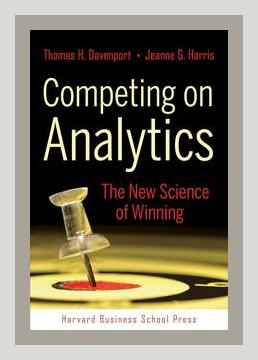Marketing and SalesBusiness StrategyTechnology and Digital TransformationBrand ManagementMarketing AnalyticsCompetitive StrategyData Analytics
Title: Competing on Analytics: The New Science of Winning
Authors: Thomas H. Davenport and Jeanne G. Harris
Publication Year: 2007
Categories: Brand Management, Marketing Analytics, Competitive Strategy, Data Analytics
Introduction
In “Competing on Analytics: The New Science of Winning,” authors Thomas H. Davenport and Jeanne G. Harris delve into the fast-evolving world of data analytics and how organizations can leverage data to gain a competitive edge. Throughout the book, the authors articulate a roadmap for companies to transition from being data collectors to becoming data-driven decision-makers.
Key Themes & Concepts
1. The Analytical Competitor
Key Point: Organizations that excel in using data analytics to drive decision-making possess substantial competitive advantages, often outperforming their peers in various industries.
Example: The authors highlight Harrah’s Entertainment, which uses customer data to fine-tune its marketing strategies and enhance customer loyalty.
Actionable Step: Establish a dedicated analytics team within the organization to focus on gathering and analyzing data to drive marketing and operational decisions.
2. Building an Analytical Capability
Key Point: Developing analytical capability involves the integration of strategy, technology, and talent.
Example: Procter & Gamble (P&G) cultivated an analytical culture by investing in cutting-edge technologies and hiring skilled data scientists.
Actionable Step: Invest in state-of-the-art analytics tools and actively recruit talent with strong analytical skills to build a robust capability.
3. The Stages of Analytical Competition
Key Point: The authors introduce a five-stage maturity model to describe the progression of analytical competition: From Analytically Impaired to Analytically Innovating.
Stages:
– Analytically Impaired: Organizations have limited data and minimal decision-making capability.
– Localised Analytics: Analytics are isolated in specific departments.
– Analytical Aspirations: Broader adoption of analytics-driven initiatives.
– Analytical Companies: Integrated analytics across multiple functions.
– Analytical Innovators: Leading-edge analytics that drive industry innovation.
Example: UPS is portrayed as an Analytical Innovator due to its sophisticated logistics and route optimization models.
Actionable Step: Assess your organization’s current stage on this maturity model and develop a roadmap for advancing to the next stage.
4. Responsibilities of Analytical Leaders
Key Point: Leadership plays a crucial role in fostering an analytical culture. This includes setting clear priorities and ensuring accountability.
Example: At Capital One, senior leaders mandate the use of analytics in virtually every business decision, ensuring consistency and rigor.
Actionable Step: As a leader, advocate for data-driven decision-making at all levels of the organization and create an accountability framework to measure progress.
5. Choosing the Right Focus Areas for Analytics
Key Point: Organizations must identify critical areas where analytics can yield the highest return on investment.
Example: Walmart’s investment in analytics to refine its supply chain operations led to cost reductions and improved inventory management.
Actionable Step: Conduct a comprehensive analysis to identify high-impact areas within your organization where analytics can drive significant improvements.
6. The Role of Technology in Analytics
Key Point: Advanced technology is indispensable for robust analytics, from data warehousing to machine learning platforms.
Example: The use of Teradata by Harrah’s Entertainment for customer relationship management underscores the importance of technology.
Actionable Step: Choose and implement advanced analytics technologies that align with your organization’s strategic objectives.
7. Talent Management and Cultivation
Key Point: Fostering a pool of skilled analysts and integrating them into the business’s strategic fabric is crucial.
Example: The authors illustrate how Novartis recruits top-tier analytical talent to enhance its R&D capabilities.
Actionable Step: Develop an intensive training program to upskill existing staff and establish relationships with academic institutions to source new talent.
8. Data Management and Quality
Key Point: Quality data is the bedrock of effective analytics; organizations must emphasize rigorous data management practices.
Example: The Royal Bank of Canada centers its data strategy on maintaining high data quality for better customer insights.
Actionable Step: Implement strict data governance policies to ensure the accuracy, consistency, and reliability of data across the organization.
9. Implementing Analytics Initiatives
Key Point: Successful analytics implementation requires well-defined processes and alignment with organizational goals.
Example: Ford Motor Company’s analytics initiative, “Warranty Analytics,” is focused on reducing warranty service costs through predictive analytics.
Actionable Step: Develop a structured implementation plan for analytics projects, clearly defining objectives, resources, and timelines.
10. Cultural Change Management
Key Point: Shifting to an analytical culture necessitates change management strategies and leadership commitment.
Example: Netflix’s transformation to a data-driven company was driven by cultural adoption of analytics in strategic decisions.
Actionable Step: Promote a culture that values data-driven insights by recognizing and rewarding analytical success stories within the organization.
Conclusion
“Competing on Analytics: The New Science of Winning” provides a comprehensive guide for organizations that aim to leverage data and analytics to gain a competitive edge. By integrating strategy, technology, talent, and culture, businesses can transition from merely collecting data to effectively applying it in ways that enhance decision-making and drive superior business outcomes. The actionable steps provided in the book offer a roadmap for organizations of all sizes to harness the power of analytics.
Summary of Key Actionable Steps:
- Build a dedicated analytics team.
- Invest in advanced analytics tools and talent recruitment.
- Assess and advance your organization’s stage in the analytics maturity model.
- Foster data-driven decision-making at all leadership levels.
- Identify and focus on high-impact analytics areas.
- Implement state-of-the-art analytics technologies.
- Develop training programs for upskilling staff in analytics.
- Ensure rigorous data governance and quality management.
- Create structured implementation plans for analytics projects.
- Promote and recognize a culture that values analytics.
Marketing and SalesBusiness StrategyTechnology and Digital TransformationBrand ManagementMarketing AnalyticsCompetitive StrategyData Analytics
